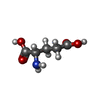| 登録情報 | データベース: PDB / ID: 4nf4
|
|---|
| タイトル | Crystal structure of GluN1/GluN2A ligand-binding domain in complex with DCKA and glutamate |
|---|
 要素 要素 | - Glutamate receptor ionotropic, NMDA 1
- Glutamate receptor ionotropic, NMDA 2A
|
|---|
 キーワード キーワード | transport protein / receptor / DCKA and glutamate |
|---|
| 機能・相同性 |  機能・相同性情報 機能・相同性情報
neurotransmitter receptor transport, plasma membrane to endosome / regulation of response to alcohol / response to ammonium ion / receptor recycling / response to hydrogen sulfide / positive regulation of inhibitory postsynaptic potential / directional locomotion / response to environmental enrichment / response to other organism / regulation of ARF protein signal transduction ...neurotransmitter receptor transport, plasma membrane to endosome / regulation of response to alcohol / response to ammonium ion / receptor recycling / response to hydrogen sulfide / positive regulation of inhibitory postsynaptic potential / directional locomotion / response to environmental enrichment / response to other organism / regulation of ARF protein signal transduction / pons maturation / response to methylmercury / positive regulation of Schwann cell migration / regulation of cell communication / EPHB-mediated forward signaling / Assembly and cell surface presentation of NMDA receptors / serotonin metabolic process / olfactory learning / response to carbohydrate / dendritic branch / cellular response to dsRNA / conditioned taste aversion / cellular response to lipid / regulation of respiratory gaseous exchange / cellular response to magnesium ion / protein localization to postsynaptic membrane / conditioned place preference / propylene metabolic process / response to glycine / sleep / locomotion / dendritic spine organization / response to manganese ion / regulation of monoatomic cation transmembrane transport / voltage-gated monoatomic cation channel activity / Synaptic adhesion-like molecules / NMDA glutamate receptor activity / regulation of NMDA receptor activity / RAF/MAP kinase cascade / parallel fiber to Purkinje cell synapse / NMDA selective glutamate receptor complex / response to morphine / cellular response to zinc ion / calcium ion transmembrane import into cytosol / glutamate binding / glutamate receptor signaling pathway / neuromuscular process / protein heterotetramerization / regulation of synapse assembly / positive regulation of calcium ion transport into cytosol / positive regulation of reactive oxygen species biosynthetic process / glycine binding / regulation of axonogenesis / male mating behavior / regulation of dendrite morphogenesis / spinal cord development / action potential / suckling behavior / startle response / response to amine / dopamine metabolic process / monoatomic cation transmembrane transport / regulation of neuronal synaptic plasticity / response to lithium ion / modulation of excitatory postsynaptic potential / associative learning / monoatomic cation transport / social behavior / excitatory synapse / ligand-gated monoatomic ion channel activity / regulation of postsynaptic membrane potential / positive regulation of excitatory postsynaptic potential / cellular response to glycine / positive regulation of dendritic spine maintenance / postsynaptic density, intracellular component / response to light stimulus / positive regulation of protein targeting to membrane / neuron development / multicellular organismal response to stress / Unblocking of NMDA receptors, glutamate binding and activation / cellular response to manganese ion / phosphatase binding / glutamate receptor binding / long-term memory / regulation of neuron apoptotic process / prepulse inhibition / monoatomic cation channel activity / calcium ion homeostasis / glutamate-gated receptor activity / synaptic cleft / cell adhesion molecule binding / response to fungicide / glutamate-gated calcium ion channel activity / presynaptic active zone membrane / dendrite membrane / ligand-gated monoatomic ion channel activity involved in regulation of presynaptic membrane potential / sensory perception of pain / response to amphetamine / ionotropic glutamate receptor signaling pathway / protein tyrosine kinase binding類似検索 - 分子機能 Glutamate [NMDA] receptor, epsilon subunit, C-terminal / N-methyl D-aspartate receptor 2B3 C-terminus / : / : / Ionotropic glutamate receptor, metazoa / Ligated ion channel L-glutamate- and glycine-binding site / Ionotropic glutamate receptor, L-glutamate and glycine-binding domain / Ligated ion channel L-glutamate- and glycine-binding site / Ligand-gated ion channel / : ...Glutamate [NMDA] receptor, epsilon subunit, C-terminal / N-methyl D-aspartate receptor 2B3 C-terminus / : / : / Ionotropic glutamate receptor, metazoa / Ligated ion channel L-glutamate- and glycine-binding site / Ionotropic glutamate receptor, L-glutamate and glycine-binding domain / Ligated ion channel L-glutamate- and glycine-binding site / Ligand-gated ion channel / : / Ionotropic glutamate receptor / Eukaryotic homologues of bacterial periplasmic substrate binding proteins. / Receptor, ligand binding region / Receptor family ligand binding region / Periplasmic binding protein-like II / Periplasmic binding protein-like I / D-Maltodextrin-Binding Protein; domain 2 / 3-Layer(aba) Sandwich / Alpha Beta類似検索 - ドメイン・相同性 4-hydroxy-5,7-dimethylquinoline-2-carboxylic acid / GLUTAMIC ACID / Glutamate receptor ionotropic, NMDA 1 / Glutamate receptor ionotropic, NMDA 2A類似検索 - 構成要素 |
|---|
| 生物種 |   Rattus norvegicus (ドブネズミ) Rattus norvegicus (ドブネズミ) |
|---|
| 手法 |  X線回折 / X線回折 /  シンクロトロン / シンクロトロン /  分子置換 / 解像度: 2 Å 分子置換 / 解像度: 2 Å |
|---|
 データ登録者 データ登録者 | Annie, J. / Tajima, N. / Furukawa, H. |
|---|
 引用 引用 |  ジャーナル: Neuron / 年: 2014 ジャーナル: Neuron / 年: 2014
タイトル: Structural Insights into Competitive Antagonism in NMDA Receptors.
著者: Jespersen, A. / Tajima, N. / Fernandez-Cuervo, G. / Garnier-Amblard, E.C. / Furukawa, H. |
|---|
| 履歴 | | 登録 | 2013年10月30日 | 登録サイト: RCSB / 処理サイト: RCSB |
|---|
| 改定 1.0 | 2014年3月12日 | Provider: repository / タイプ: Initial release |
|---|
| 改定 1.1 | 2017年8月9日 | Group: Advisory / Refinement description / Source and taxonomy
カテゴリ: entity_src_gen / pdbx_unobs_or_zero_occ_atoms / software |
|---|
|
|---|
 データを開く
データを開く 基本情報
基本情報 要素
要素 キーワード
キーワード 機能・相同性情報
機能・相同性情報
 X線回折 /
X線回折 /  シンクロトロン /
シンクロトロン /  分子置換 / 解像度: 2 Å
分子置換 / 解像度: 2 Å  データ登録者
データ登録者 引用
引用 ジャーナル: Neuron / 年: 2014
ジャーナル: Neuron / 年: 2014 構造の表示
構造の表示 Molmil
Molmil Jmol/JSmol
Jmol/JSmol ダウンロードとリンク
ダウンロードとリンク ダウンロード
ダウンロード 4nf4.cif.gz
4nf4.cif.gz PDBx/mmCIF形式
PDBx/mmCIF形式 pdb4nf4.ent.gz
pdb4nf4.ent.gz PDB形式
PDB形式 4nf4.json.gz
4nf4.json.gz PDBx/mmJSON形式
PDBx/mmJSON形式 その他のダウンロード
その他のダウンロード 4nf4_validation.pdf.gz
4nf4_validation.pdf.gz wwPDB検証レポート
wwPDB検証レポート 4nf4_full_validation.pdf.gz
4nf4_full_validation.pdf.gz 4nf4_validation.xml.gz
4nf4_validation.xml.gz 4nf4_validation.cif.gz
4nf4_validation.cif.gz https://data.pdbj.org/pub/pdb/validation_reports/nf/4nf4
https://data.pdbj.org/pub/pdb/validation_reports/nf/4nf4 ftp://data.pdbj.org/pub/pdb/validation_reports/nf/4nf4
ftp://data.pdbj.org/pub/pdb/validation_reports/nf/4nf4 リンク
リンク 集合体
集合体
 要素
要素



 X線回折
X線回折 試料調製
試料調製 シンクロトロン / サイト:
シンクロトロン / サイト:  NSLS
NSLS  / ビームライン: X25 / 波長: 1 Å
/ ビームライン: X25 / 波長: 1 Å 解析
解析 分子置換 / 解像度: 2→19.903 Å / SU ML: 0.21 / σ(F): 1.38 / 位相誤差: 22.09 / 立体化学のターゲット値: ML
分子置換 / 解像度: 2→19.903 Å / SU ML: 0.21 / σ(F): 1.38 / 位相誤差: 22.09 / 立体化学のターゲット値: ML ムービー
ムービー コントローラー
コントローラー






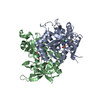
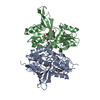



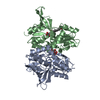
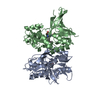
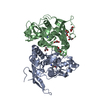
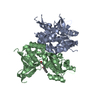

 PDBj
PDBj






